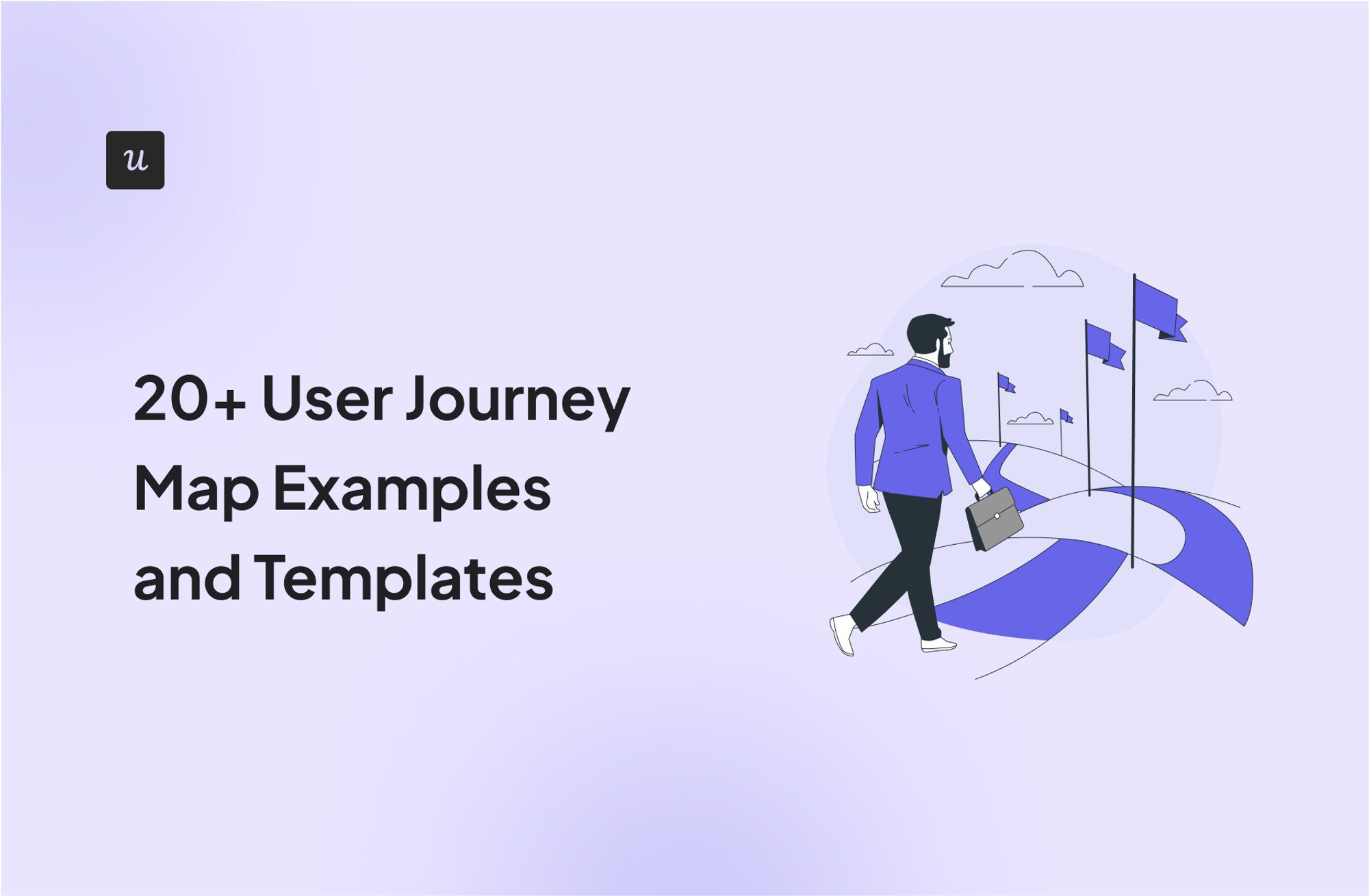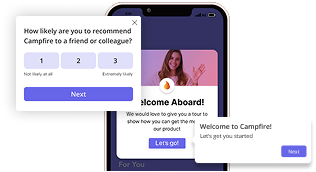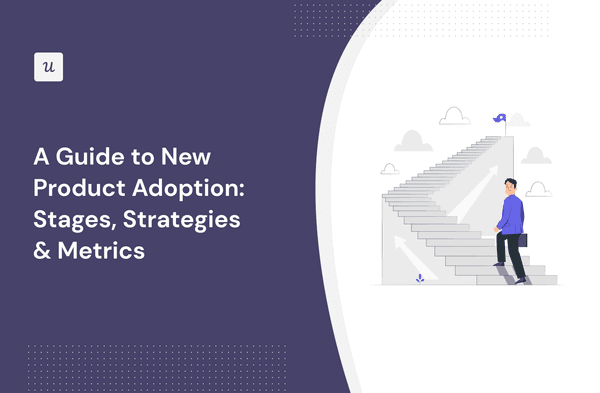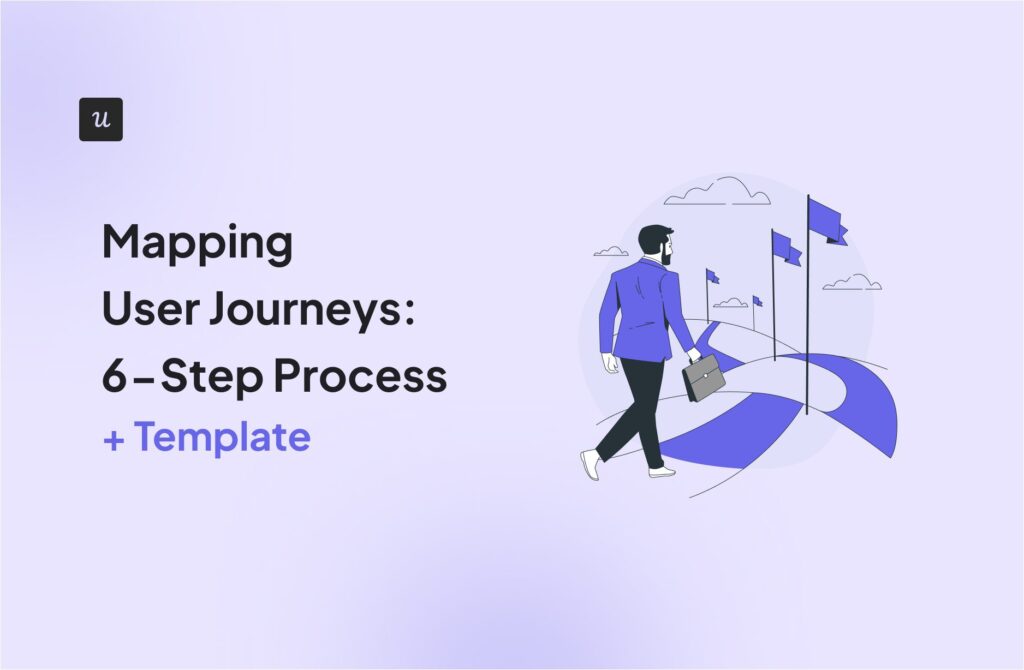
Looking for user journey map examples to visualize your customer’s experience? You’re in the right place.
A customer journey map visually represents the steps a user takes to achieve a specific goal with your product or service. By mapping this journey, you can identify friction points and opportunities to improve the overall user experience and avoid customer churn. For instance, you might discover the need for better user onboarding to boost user retention.
We’ve compiled over 20 user journey examples and templates to spark your creativity and guide you in creating your own effective maps.
You’re looking at user journey map examples. What’s the main goal for your own map?
Try Userpilot Now
See Why 1,000+ Teams Choose Userpilot

User and customer journey map examples
Let’s dive into some user journey map examples from various successful businesses to give you a clearer picture of how these maps are used in practice.
1. Spotify’s music-sharing user journey map
Spotify, a popular music streaming platform, offers a variety of features. This customer journey map example illustrates a Spotify user’s experience when sharing music with friends and family.
The map details the steps a user takes to find and share music, along with their thoughts, emotions, touchpoints, and actors involved. It begins with the user opening Spotify to listen to music at work and exploring different playlists with excitement.
Once they find a song that resonates with them, they share it with a friend via WhatsApp and await a response.
This example is particularly insightful because it includes the actions, thoughts, and feelings of two distinct personas, providing a comprehensive view of the sharing experience.
2. Uber’s first experience user journey map
Uber, a well-known transportation company, uses this current-state customer journey map to illustrate the steps a new user takes from deciding to use Uber to arriving at their destination.
The map includes screenshots that show the user’s view at each stage of the journey, providing a clear understanding of the user interface and experience.
This example also includes the persona’s goals and verbatim thoughts, along with emotion tags that offer deeper insights into the target persona.
The bottom of the map shares critical insights that help marketing and sales teams understand the user better and improve their overall experience.
3. Dropbox’s customer journey map
This journey map incorporates the user persona’s jobs-to-be-done (JBTD) and the path they follow from the problem-awareness stage.
Given that Dropbox is a cloud storage platform, its adoption impacts the daily operations of all workers. As such, this map includes a “cast” section that profiles everyone affected by the decision to use Dropbox.
Sophia’s journey begins when she discovers Dropbox, researches alternatives, books a demo, and signs up for the application.
This appears to be a future-state journey map, as it is simplified compared to a current-state map.
4. Mailchimp’s day-in-the-life customer journey map
Mailchimp, a popular email marketing platform, uses this customer journey map to capture everything a marketing worker named Dani does every two weeks.
This map compiles all the tasks Dani completes before, during, and after sending a marketing email.
It is considered a day-in-the-life map because it includes more detail than simply outlining the steps Dani takes to send an email. Instead, it includes digressions, emotions, and areas of opportunity.
5. HubSpot’s customer journey map
HubSpot offers a range of services for managing a business. This current-state map illustrates everything a user does from the moment they become dissatisfied with their previous tools.
This map details how customers interact with HubSpot until they become paying users. It includes all actors involved, factors that lead to a positive or negative experience, and key decision points.
The map also includes thoughts and sentiments, friction points, customer touchpoints, and internal actors.
6. Netflix’s customer journey map
Similar to the Mailchimp example, this customer journey map explains the macro steps a user like Jen takes to watch a movie on Netflix.
As a media streaming platform, Netflix relies on its algorithm to provide movie and TV show recommendations. This map illustrates how Jen disregards these recommendations and searches for an alternative movie, highlighting an area of opportunity for the Netflix team.
The analysis includes Jen’s pain points, motivators, and emotions. Breaking the journey down into smaller goals simplifies spotting friction points by showing an end-to-end process on a single screen.
7. Canva’s user journey map
Canva, an online graphic design platform, is designed for non-designers. This user journey map tells the story of Laura, who wants to create beautiful flyers to promote her hobby.
The map walks us through the process of creating a new design, starting with Laura creating a board and ending with her exporting the design. Similar to the Netflix example, this map is limited to a single scenario.
This user journey also includes actions, customer pain points, goals, customer expectations, and thoughts across the phases.
8. Zoom’s user journey map
Zoom, a popular online meeting platform, serves various purposes. This example focuses on Zoom for teachers and is broken down into three main categories: Action, emotions, and thinking.
This user journey map explains what a teacher does to give online lectures. It is separated into five main action buckets with a breakdown of the tasks that fall under it. For example, to “start teaching,” a teacher needs to open Zoom and start the call.
You can also see how the teachers’ emotions and thoughts vary throughout the session. The design of this map allows for quick identification of opportunities just by looking at the emojis.
9. HeartiCraft’s user journey map
HeartiCraft is an online store for handcrafted products. The experience begins when the user researches and finds the website, and ends when they decide to buy again.
This user journey map exposes where HeartiCraft excels and where it fails to delight users.
The map highlights four different stages, including actions, thoughts and feelings, pain points, and delights, under each.
10. Say Yeah!’s customer journey map
Say Yeah! helps businesses deliver products and services that better serve neurodiverse users. To analyze this customer journey, start on the left side of the screen and follow the stages.
This map illustrates the journey of an adult child looking for health support for their parents, starting when they discover a problem and ending after they make a purchase.
The map includes tasks, actors, emotions, media, tactics, and the user’s thinking process across the stages. It also shows the relevance of each moment for serving the customer properly.
11. Gartner’s B2B customer buying journey map
Gartner, a consulting firm, demonstrates a deep understanding of the B2B sales process in this example, portraying the B2B buyer’s journey as a non-linear path.
This is informed by historical customer behavior, journey analytics, and user research. The map outlines four main actions across the user’s journey that enable them to buy a product.
The map captures internal discrepancies, such as the person meeting with the company not necessarily being the decision-maker and needing to get the CEO’s approval before making a purchase.
12. Service blueprint map for technical support
As mentioned earlier, a service journey map helps employees understand what needs to happen internally to support customer-facing tasks. This example illustrates how systems are interconnected and linked to company policies.
This map also shows the actions employees take to provide service, including the invisible back-end tasks and the evidence that supports each action.
Templates for user and customer journey mapping process
Here are some templates to help you get started with your own user journey mapping process.
1. Userpilot’s current user state journey map
To understand the current user experience, Userpilot can help you perform a path analysis.
Path analysis lets you see how users navigate your product, highlighting key interactions and touchpoints. This is invaluable for optimizing the user journey.
For example, to optimize conversion rates, you can analyze how enterprise users reach the conversion point. You can then replicate this experience for new users to guide them toward the same success.
2. User journey map template in Figma
Use this Figma template for your customer journey mapping exercise to uncover user activities and emotions across different stages, from realizing their needs to becoming a paid customer.
It allows you to add your expectations for the user’s emotions, experience, and expectations at each stage.
You can include as many ideas as you wish on this canvas or even invite your teams to work on this together.
3. User empathy mapping template in Notion
An empathy map compiles your target user’s feelings, thoughts, and behaviors.
This Notion template follows the classical approach by including the four main categories:
- Says: Direct quotes or statements that provide insight into the user’s thoughts and opinions.
- Thinks: Reflects the user’s thoughts, beliefs, and feelings.
- Does: Includes what the user does in real life or during their interaction with a product or service.
- Feels: Fears, frustrations, joys, and other emotional responses.
4. Future state customer journey map template from Xtensio
Use your creativity and your current state journey map to fill out this template. Explore alternative customer paths to offer a better customer experience.
This template includes space to add:
- Stages of the journey.
- Users’ thoughts and feelings.
- Actions and touchpoints.
- How does this map differ from the current journey?
5. Service blueprint customer journey map template from Miro
This is a typical service blueprint template.
Miro lets you edit it to your liking by following these steps:
- Define the customer service scenario to investigate.
- Plot customer actions in chronological order.
- Lay out processes, actors, and support systems.
- Add roles and responsibilities by specifying interactions, visibility, and internal actions.
- Illustrate cross-functional relationships.
6. Customer journey map template from Mural
Use Mural’s customer journey map template for a better understanding of your target audience’s touchpoints, needs, motivations, and barriers.
Here you can:
- Establish a customer scenario, e.g., buying a shirt online.
- Define the customer steps, including big and small actions.
- List all customer interactions with your brand, either in physical or digital touchpoints.
- Determine your customer’s goals and motivations.
- Highlight the positive moments at each stage.
- Define the negative or frustrating moments across the journey.
7. Customer journey map template from Canva
Find many different customer journey map templates on Canva.
These all let you edit the customer actions across stages, and depending on the option that you choose, you’ll also be able to add the user’s:
- Emotions and feelings.
- Thinking process.
- Physical or digital touchpoints.
- Barriers or pain points.
- Solutions to barriers.
8. Customer touchpoint map template from InVision
Map out the customer touchpoints on this InVision template.
Here, you’ll be able to list all the different interactions between the user and your business, as well as mention all the involved actors. You can break down the actions by stages and teams.
9. Customer journey mapping template from Slidesgo
Slidesgo provides you with 29 customer journey mapping examples.
You can choose the design that piques your interest the most and add the different stages, touchpoints, actions, and sentiments. These designs are mostly suited for journeys of up to five steps.
10. B2B customer journey map template from UXPressia
UXPressia developed a set of B2B/B2C customer journey map templates for you to use. This mix also includes persona templates to guide you when creating personas for your journey maps.
You can use these templates as-is to guide your thinking or adapt them to fit your specific project needs.
11. Customer journey map template from Conceptboard
This customer journey map template is a classic one. Open the file with a clear understanding of your user persona.
There, you’ll be able to add customer data concerning each stage, more specifically regarding their:
- Goals.
- Actions.
- Touchpoints and channels.
- Thoughts.
- Overall experience.
- Pain points.
- Areas of improvement.
User journey maps vs customer journey maps
While often used interchangeably, user journey maps and customer journey maps have distinct differences in scope, definitions, and goals. Understanding these nuances can help you choose the right approach for your specific needs.
Here’s a breakdown of their key differences:
- Scope: User journey maps typically focus on a user’s experience with a specific product or service, while customer journey maps visualize the end-to-end experience across all brand touchpoints.
- Definitions: In a user journey map, a touchpoint refers to interface interactions and in-app experiences. In a customer journey map, a touchpoint encompasses every interaction a customer has with your brand, such as advertisements, customer support, or checkout processes.
- Goals: User journey maps are valuable for influencing product design improvements, while customer journey maps inform broader business strategies and customer engagement efforts.
Types of user and customer journey maps
Customer journey maps can be adapted for various purposes, influencing different aspects of your business. For example, a day-in-the-life journey map can help you identify opportunities to engage with customers in their daily routines.
Here are several types of user and customer journey visualization methods to consider:
- Current-state map: Illustrates the critical user journey as it exists now. It helps you visualize the current state of the user experience based on facts, allowing you to identify strengths and opportunities for improvement.
- Future-state map: Designs how you want the customer’s journey to look in the future. This type is aspirational and useful for speculating on potential customer paths, based on real customer data from the current state map and creative thinking.
- Day-in-the-life map: Lists everything a customer does throughout the day, regardless of whether it relates to your brand. This map provides a comprehensive understanding of who your customer is, how they spend their time, and where your company fits into their lives. It is based on user research data.
- Service-blueprint map: This internal document outlines all the actions, policies, and processes that support customer-facing services. It helps employees understand their roles in meeting customer needs throughout the journey.
Conclusion
Exploring user journey map examples can inspire you to enhance your customers’ experience by pinpointing critical areas, such as better onboarding processes.
To create an effective customer journey map, you need a deep understanding of your user and a clear mapping path, i.e., by conducting user interviews and contextual research.
Userpilot is an all-in-one product platform that can equip you with actionable customer journey insights. Get a demo to explore our powerful analytics capabilities!
FAQ
What are the key elements of a user journey map?
A user journey map typically includes the ideal customer persona, stages of the journey, user actions, touchpoints, emotions, pain points, and opportunities for improvement.
How do you create a user journey map?
To create a user journey map, you need to define the scope, gather user research via customer surveys, create user personas, map out the stages, identify touchpoints, analyze emotions, and identify opportunities.
What is the purpose of a user journey map?
The purpose of a user journey map is to visualize and understand the user’s experience, identify pain points, and discover opportunities to improve the overall user experience.
How do you use a user journey map?
Use a user journey map to inform design decisions, prioritize improvements, align teams, and create a better customer experience.
What are the benefits of user journey mapping?
The benefits of user journey mapping include improved customer satisfaction, increased conversion rates, better product design, and enhanced team alignment.
What tools can you use to create user journey maps?
Tools for creating user journey maps include Miro, Mural, Figma, and UXPressia.
How often should you update your user journey map?
Update your user journey map regularly, especially when there are significant changes to your product, customer base, or business strategy.






























